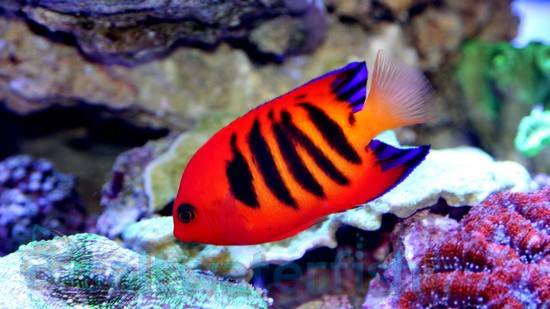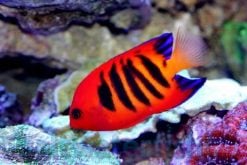Flame Angelfish (Centropyge loriculus)
Quick Stats for Flame Angelfish (Centropyge loriculus)
- Care Level: Moderate
- Temperament: Semi-aggressive
- Diet: Omnivore
- Reef Safe: No
- Minimum Tank Size: 30 gallons
- Maximum Size: 4 inches
- Water Parameters: pH 8.1-8.4, salinity 1.023-1.025, temperature 72-78°F
Comprehensive Guide: Flame Angelfish (Centropyge loriculus)
The Flame Angelfish, also known as Centropyge loriculus, is a popular species in saltwater aquariums. Here is a comprehensive guide to help you understand and care for this beautiful fish:
Habitat
The Flame Angelfish is native to the Indo-Pacific region, particularly around the reefs of the Philippines, Indonesia, and Papua New Guinea. It inhabits coral reefs and lagoons, preferring areas with plenty of hiding spots and caves.
Reef Safe
The Flame Angelfish is not considered reef safe. It is known to nip at corals and other invertebrates, potentially causing damage to a reef tank. It is best kept in a fish-only or a well-established mixed reef tank with caution.
Size
The Flame Angelfish can grow up to 4 inches in length. When selecting a tank for this species, consider its maximum size and provide enough space for it to swim comfortably.
Temperament
The Flame Angelfish has a semi-aggressive temperament. It may display territorial behavior towards other fish, especially other angelfish. Introducing it to the tank last or providing ample hiding spots can help reduce aggression.
Sexual Dimorphism
The Flame Angelfish does not exhibit significant sexual dimorphism, making it difficult to visually determine the sex of an individual.
Lifespan
The average lifespan of a Flame Angelfish in captivity is around 5 to 7 years. With proper care and a suitable environment, they can live even longer.
Diet in Aquariums
The Flame Angelfish is an omnivore and requires a varied diet. Offer a mix of high-quality flakes, pellets, frozen foods like brine shrimp and mysis shrimp, as well as occasional live foods. Supplement their diet with algae-based foods to mimic their natural feeding habits.
Aquascaping Recommendations
When aquascaping for Flame Angelfish, provide plenty of hiding spots and caves using live rock formations. This will help create a sense of security for the fish and reduce aggression towards tankmates.
Captive Bred Availability
The Flame Angelfish is occasionally available as captive-bred specimens. Captive-bred fish are generally hardier and less prone to diseases compared to wild-caught specimens. Check with reputable aquarium stores or breeders for availability.
Compatibility with Other Fish, Invertebrates, or Corals
The Flame Angelfish can be kept with other peaceful to semi-aggressive fish species that are not too similar in appearance. Avoid keeping them with other angelfish, as territorial disputes may arise. Invertebrates and corals should be chosen carefully, as the Flame Angelfish may nip at their polyps or tentacles.
5 Recommended Tankmates
Here are five tankmates that can coexist well with Flame Angelfish:
- Clownfish: Clownfish are peaceful and can form a symbiotic relationship with anemones, adding color and activity to the tank.
- Gobies: Gobies are small, peaceful fish that can inhabit the lower regions of the tank, adding diversity to the ecosystem.
- Firefish: Firefish are peaceful and have vibrant colors, making them great companions for the Flame Angelfish.
- Royal Gramma: Royal Grammas are peaceful and add a contrasting color to the tank with their purple and yellow hues.
- Blennies: Blennies are known for their comical behavior and can help control algae growth in the tank.
These tankmates are compatible due to their peaceful nature and differences in appearance, reducing the likelihood of territorial conflicts.
Other Common Names
The Flame Angelfish is also commonly known as the Red Flame Angelfish or Flame Angel.
Why Buy from Reefs4Less.com
Reefs4Less.com is a reputable online retailer that specializes in saltwater aquarium supplies. They offer a wide range of high-quality products, including Flame Angelfish, at competitive prices. With their expertise and excellent customer service, Reefs4Less.com ensures a smooth and reliable shopping experience for all aquarium enthusiasts.
Popular Questions and Answers
- Q: Can Flame Angelfish be kept in a reef tank?A: While Flame Angelfish are not considered reef safe, they can be kept in a well-established mixed reef tank with caution. Provide ample hiding spots and monitor their behavior closely.
- Q: How often should I feed my Flame Angelfish?A: Feed your Flame Angelfish small amounts multiple times a day. Aim for at least two to three feedings daily to ensure they receive a balanced diet.
- Q: Are Flame Angelfish suitable for beginners?A: Flame Angelfish are best suited for intermediate to experienced hobbyists due to their specific care requirements and potential aggression towards tankmates.
- Q: Can Flame Angelfish change their coloration?A: Yes, Flame Angelfish can change their coloration slightly depending on their mood, health, and environment. They may appear brighter or darker at times.
- Q: How can I reduce aggression in my Flame Angelfish?A: Introduce the Flame Angelfish to the tank last and provide plenty of hiding spots and caves. This will help establish territories and reduce aggression towards other fish.
| Size | 2 – 3 inches |
|---|



Reviews
There are no reviews yet.